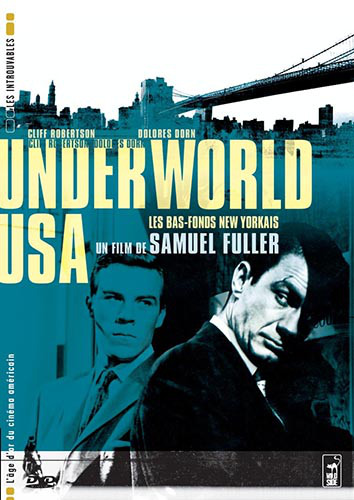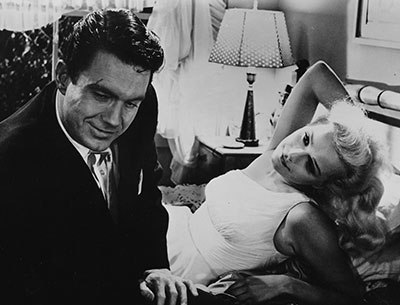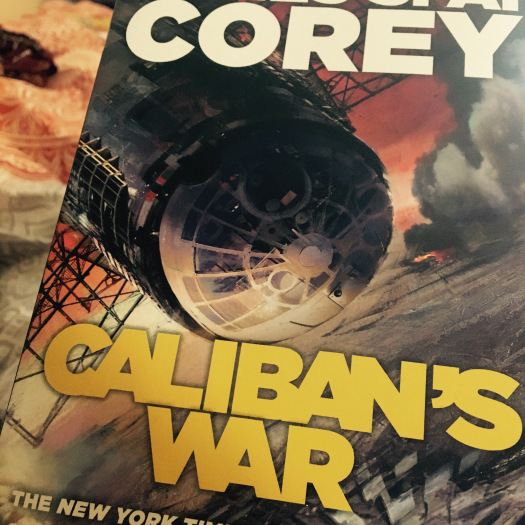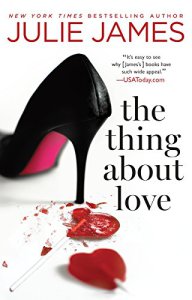If I hadn’t known otherwise in advance, I’d have thought that Sam Fuller‘s 1961 “Underworld U.S.A.” dated from a decade or so earlier, when the existence of organized crime above the local level was first being explained to Hollywood movie audiences — movies like “The Street with No Name” (1948). “Thieves Highway” (1949 and “Phenix City Story” (1955)..

“Underworld USA” does not seem to me to be more violent a revenge noir than “The Big Heat” (1953). It is also less outlandish than most Fuller movies, lacking the quirkiness of “Pickup on South Street” (1953) and others I think that it is the most conventional Sam Fuller movie I’ve seen.
At the start a fourteen-year-old boy sees his father gunned down outside the “Elite,” the dive run by his father’s girlfriend Sandy (Beatrice Kay), Tolly Devlin refuses to tell the police investigator, Driscoll (Larry Gates), but swears to make the killer pay.
Tolly is a safe cracker and serves a 5-year prison term, during which he finds one of the four, Vic Farrar, learns the names of the other three and slits Farrar’s throat.
Out of prison, staying with Sandy, Tolly (Cliff Robertson plays the adult Tolly) begins infiltrating the rackets, starting with Gela (Paul Dubov) and the other killers who have become bosses of particular rackets, Gunther (Gerald Milton), and Smith (Allan Gruener). (They are underlins of Conners (Robert Emhardt), who spends his time in a bathrobe by a swimming pool where “underprivileged children” have meets once a month.)
Tolly acquires a peroxided moll, Cuddles (Dolores Dorn) who seems to have had a heroin habit and was about to be bumbed off by Gela’s muscle, Gus (Richard Rust, the most memorable gunsel since/after Elisha Cook, Jr. in “The Maltese Falcon,” but much better at his job).
With the aid of Driscoll or aiding Driscoll, Tolly sets up his father’s killers to stop trusting each other and to kill each other off. Cuddles wants to settle down and live happily ever after with him — after testifying that is. Witnesses don’t generally live to take the stand, but…
I particularly enjoyed the scene in which Sandy lights into Tolly, calling Cuddles a giant and Tolly a midget. I guess Sandy’s collection of baby dolls is a trace of the usual Fuller perversity, and the femmes fatales with hearts of cold under tough exteriors in Fuller movies tended to platinum/peroxide blond (Constance Tower being the most memorable one in “The Naked Kiss”).

Other than the ferocity of Cliff Robertson’s performance, there is nothing out of the ordinary in this relatively late noir that feels like an earlier organized crime illustration. Robertson had quite a vicious gleam and played some ruthless characters during the early 1960s (The Best Man, for one). It is said that “you can fool all of the people some of the time and some of the people all of the time,” but it seems that the mob bosses here are easily fooled.
There’s not much (if any!) chemistry between Robertson and Dolores Dorn, but he does relate convincingly with Beatrice Kay as his surrogate mother.
Cinematographer Hal Mohr shot movies in many genres, but was not a notable noir cinematographer (except for Don Siegel’s 1958 “The Lineup”; I haven’t seen “Woman on the Run” or Siegel’s “Babyface Nelson”).
The pacing is erratic, there is (as in all Fuller movies) some clumsy dialogue along with the quirky women and obsessive men. There are worse ways to while away 99 minutes, but there are also many better noirs and gangster movies.
©2017, Stephen O. Murray
Advertisements Share this:





